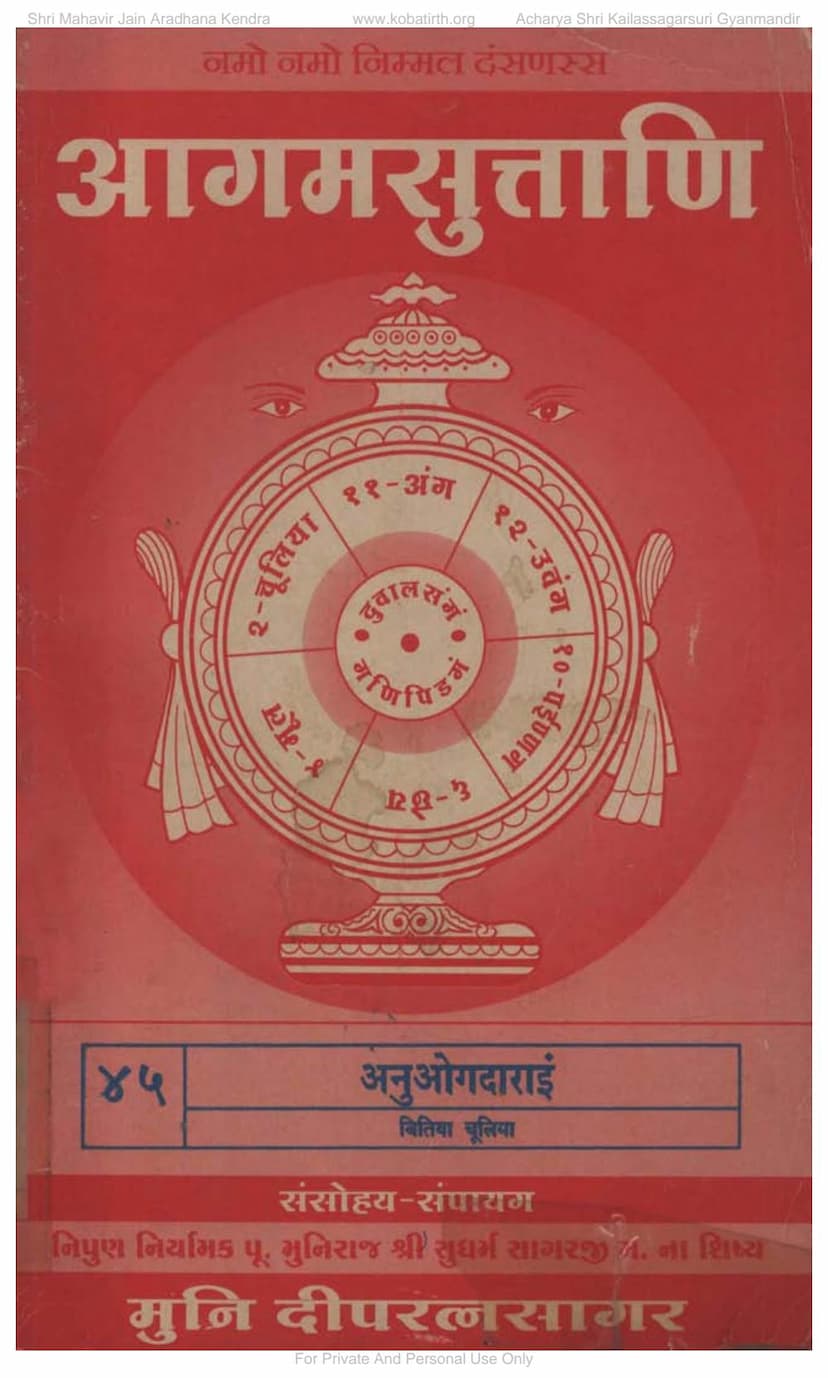Agam 45 Anuogdaram Chulikasutt 02 Moolam
Added to library: September 1, 2025

Summary
Here's a comprehensive summary of the provided Jain text, "Agam 45 Anuogdaram Chulikasutt 02 Moolam":
This document is the second Chulika (appendix) of the Anuogdar (Anuyogdvara) Sutra, which is the 45th Agama in the Jain canon. The text is a detailed exposition and classification of various concepts within Jain philosophy, primarily focusing on knowledge (naya) and its manifold aspects, as well as time (kala), space (kshetra), and other categories.
Key Concepts and Structures:
The text is highly structured and utilizes a question-and-answer format, often asking about the nature, types, and classifications of different elements. The core of the text seems to revolve around a systematic analysis of:
- Naya (Standpoints/Approaches to Knowledge): The text explores the concept of "Naya" extensively, which refers to different perspectives or standpoints from which reality can be understood. It delves into various types of Naya, their characteristics, and how they relate to each other.
- Anuog (अनुयोग - Exposition/Classification): This is the central theme. The text provides detailed classifications and analyses of numerous Jain concepts, breaking them down into different categories based on various criteria.
- Dravya (Substance): The nature and classification of substances are discussed, including their derivation from Agama (scriptural sources) and Non-Agama (external sources).
- Kala (Time): The text categorizes time in great detail, from the smallest units (like instants) to vast cosmic cycles (like Pralaya and Kalpa).
- Kshetra (Space/Realm): Different regions and spatial classifications within the Jain cosmology are described.
- Bhava (State/Disposition): The text analyzes various states and mental dispositions.
- Vachana (Speech/Language): The analysis extends to the nature of speech, its different types, and how it is used to convey meaning.
- Gana (Collection/Group): Concepts related to collections and groups are examined.
- Sutra (Thread/Verse): The text also touches upon the structure and classification of scriptures themselves.
- Anu-pūrvī (अनुपूर्वी - Succession/Order): A significant portion is dedicated to the concept of order and succession across various categories like substance, space, time, and qualities. This includes detailed discussions on the various ways to understand this sequential ordering.
- Names (Nāma - नाम): The text delves into the classification and etymology of names, including single-name (ek-nāma), dual-name (dvi-nāma), and multi-name (tri-nāma) categories, exploring their linguistic and philosophical implications.
- Qualities (Guna - गुण): The inherent qualities of substances, both living (Jiva) and non-living (Ajiva), are analyzed, covering aspects like color, smell, taste, touch, and form.
- Avayava (Parts/Components): The text discusses how wholes are composed of parts and how these parts relate to the whole.
- Samyoga (Combination/Association): The concept of how different elements combine and interact is explored.
- Pramana (Measure/Standard): Various means of measurement and standards for understanding reality are discussed.
- Naya (Standpoints): Different philosophical standpoints (like Nigama, Sangraha, Vyavahara, Rjusutra) are analyzed in relation to their application to the categories.
- Gati (Motion/State): The text discusses different states of existence and movement.
- Āyu (Lifespan): The durations of lifespans for various beings across different realms are meticulously detailed.
- Avachhed (Separation/Limitation): The concept of limitations and boundaries is addressed.
Structure and Methodology:
The Anuogdar Sutra, as presented in this excerpt, is characterized by:
- Rigorous Classification: A primary method is the exhaustive classification of every concept into multiple categories based on different criteria.
- Hierarchical Breakdown: Concepts are often broken down from broader categories into more specific sub-categories.
- Linguistic and Philosophical Analysis: The text engages in deep linguistic analysis, examining the meaning and application of terms. It also explores philosophical distinctions and relationships between concepts.
- Agamic and Non-Agamic Distinction: The origin and validity of knowledge and categories are often traced back to either scriptural sources (Agama) or external understanding (Non-Agama).
- Enumeration and Definition: The text meticulously enumerates and defines various classifications, often providing examples or analogies.
Key Sections and Chapters (Implied by the structure):
Based on the progression of topics, one can infer sections dedicated to:
- Types of Knowledge (Jnana).
- The nature of "Anuog" and its application.
- Detailed classification of "Naya" and its various subdivisions.
- The nature and types of "Dravya," "Kshetra," "Kala," and "Bhava."
- The concept of "Anu-pūrvī" and its application across different categories.
- The classification of "Nama" (Names) and their linguistic properties.
- The classification of "Guna" (Qualities).
- The analysis of "Vachana" and its subdivisions.
- The detailed discussion of "Samyoga" (combinations).
- The intricate analysis of "Pramana" (measures).
- The profound exploration of "Naya" with its various interpretations and applications.
- The extensive categorization of "Kala" (time) and "Kshetra" (space).
- The detailed study of "Ayu" (lifespan) for different beings.
- The classification of "Achhed" (limitations) and their philosophical implications.
Overall Significance:
This text represents a profound and systematic attempt to categorize and analyze the Jain philosophical framework. It showcases the intellectual depth of Jain tradition in its pursuit of understanding reality through rigorous logical and linguistic analysis. The Anuogdar Sutra serves as a foundational text for understanding the intricate details and interrelationships of Jain doctrines. The detailed enumerations and classifications provide a roadmap for a comprehensive understanding of the Jain worldview. The text emphasizes the importance of correct perspective (Naya) and diligent investigation (Anuog) in the pursuit of true knowledge.